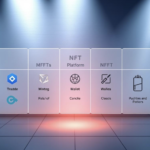Now Reading: Guide on How to Read Cryptocurrency Whitepapers Effectively
- 01
Guide on How to Read Cryptocurrency Whitepapers Effectively
Guide on How to Read Cryptocurrency Whitepapers Effectively

White papers act as a project’s manifesto and technical manual. They lay out the problem, the proposed solution, tokenomics, roadmap, and team credentials. That clarity helps people judge a project’s real promise.
The bitcoin white paper and Vitalik Buterin’s Ethereum paper changed the market by giving clear technical roadmaps. This guide explains what to expect in a paper and why those sections matter for investors in the United States.
What you will gain: a practical, step-by-step approach for spotting strong tokenomics, credible roadmaps, and qualified teams. We preview a two-pass reading workflow and external checks like audits and repo activity.
Note: white papers provide core information but do not replace independent diligence or professional advice. Follow the process here to save time and compare projects with confidence.
Why white papers still matter in today’s crypto market
White papers now span formal research and investor-facing guides. That split matters because style often signals substance and intent.
From the Bitcoin white paper to modern docs
The term “white paper” moved from policy briefs into tech and finance. The 2008 bitcoin white paper set a concise, academic baseline that many developer-focused projects still follow.
Over time, some teams traded depth for design. Many contemporary white papers look like pitch decks and aim at investors. Others publish living docs on GitBook, which can show an engaged team that updates tokenomics, specs, and audits over time.

Marketing vs. academic tone: what the style tells you
An academic paper often contains architecture diagrams, math, and repo links. That tone suggests technical claims you can test.
Marketing-forward papers use simpler language and bright layouts. That style demands extra verification outside the document.
- Why they still matter: one consolidated source for purpose, architecture, token model, roadmap, and team.
- A clear problem statement is a good example of useful information.
How to read cryptocurrency whitepapers effectively
An efficient workflow saves time and reveals real signals. Start with a fast pass that checks whether the document lists an introduction, technical details, tokenomics, roadmap, and team. This sweep helps you decide if the paper merits a deeper analysis.

Skim first, then deep-dive: a two-pass reading workflow
On pass one, note missing chapters and bold claims. Flag gaps early so you do not waste effort on low-quality projects.
On pass two, map the problem, the proposed solution, and specific differentiation from competitors. Record measurable goals and success criteria that the team can later be held to.
Verify claims outside the PDF
Build a checklist: cross-check the official site, GitBook updates, code repositories, audits, and mainnet or testnet status. Look for recent commits, active contributors, and published security reviews.
- Token model: record distribution, supply schedule, utility, and vesting and confirm via token contracts.
- Technology: evaluate consensus, smart contracts, scalability, and interoperability claims.
- Team & track record: verify identities on LinkedIn and prior public work.
Finish by listing open questions and seeking answers in FAQs, AMAs, or repos. Unanswered critical questions are valid risk signals in this crypto space.
Break down the core sections: what “good” looks like
A clear, practical white paper lays out the real problem and the measurable value a project delivers. Good documentation separates claims from evidence and points the reader to verifiable data.

Problem and value proposition
Look for precision over marketing. A strong problem section cites context, scope, and measurable outcomes. Stellar’s example is useful: it names the pain and the market impact.
Technology essentials
The paper should explain the chosen blockchain, consensus trade-offs, smart contract architecture, and any off‑chain components that affect trust or speed.
Tokenomics and distribution
Transparent token distribution, explicit vesting, and clear token supply mechanics matter. Utility must link to demand drivers and governance roles.
Roadmap realism and team
Milestones should prioritize core features and include contingency plans. The team must be named, verifiable, and show past delivery on similar projects.
- Signals of quality: architecture diagrams, audit links, repo activity, and live deployments.
- Risk flags: large insider allocations, missing vesting, or vague utility claims.
| Section | What to expect | Good example | Red flag |
|---|---|---|---|
| Problem | Measurable pain, market size | Stellar | Vague claims |
| Technology | Consensus, contracts, off‑chain | Detailed diagrams | No specs |
| Tokenomics | Distribution, supply, utility | Transparent allocation | Hidden vesting |
| Roadmap & Team | Realistic milestones; verifiable team | Staged releases; resumes | Ambiguous timeline; anonymous team |
Assessing the technology stack and architecture
Look beyond marketing: the technology behind a project determines scalability, risk, and developer interest.
Consensus, scalability, and security trade-offs
Check which consensus model the paper names—PoW, PoS, or a hybrid—and note the trade-offs in energy, rewards, and decentralization.
Look for explicit throughput targets and whether the design uses L2s, sharding, or app‑specific chains. If numbers are missing, treat claims as unverified.
Verify security practices: formal audits, bug bounties, cryptography choices, and incident playbooks that limit damage.

Interoperability and developer community health
Assess bridge plans, standards, and listed integrations. Check repo activity, SDKs, and docs. Active contributors signal longer term support.
Does this need a blockchain at all?
Ask whether the use case gains from decentralization, auditability, or tokenized incentives. Some systems run cheaper and simpler on a traditional database.
| Area | What to check | Risk indicator |
|---|---|---|
| Consensus | Model, validator incentives, energy impact | No explanation or vague claims |
| Scalability | Throughput targets, L2s, sharding plan | No metrics or unrealistic numbers |
| Security | Audits, bug bounties, incident playbook | Missing audits or closed code |
| Developer health | SDKs, docs, commits, contributors | Stale repos and absent tooling |
Reading tokenomics with investor-level rigor
Careful scrutiny of token mechanics reveals if incentives align with long-term network health. Investors should treat the token section as a governance and funding map. Focus on who holds early power and when supply changes occur.
Distribution and vesting: who holds power and when
Demand transparency on allocations for team, investors, treasury, and ecosystem funds. Clear vesting schedules prevent sudden supply shocks that can hurt holders.
Utility, governance, and value accrual mechanics
Check whether the token grants governance rights, staking yields, fee reductions, or access. Prefer models that tie token demand to real protocol activity.
Inflationary vs. deflationary models and max supply signals
Note whether the token supply is capped, has emissions, or uses burns. Inflationary designs require sustained adoption to preserve value. Deflationary levers can support price but may reduce liquidity.
- Checklist: public token distribution, encoded vesting, emissions schedule, and revenue routing.
- Model unlock timelines for dilution risk and governance impact.
- Verify claims against contracts or explorers and compare with other papers for patterns.
| Model | Signal | Investor implication |
|---|---|---|
| Capped supply | Max supply stated | Less inflation risk |
| Emission schedule | Planned minting | Requires growth metrics |
| Burns/buybacks | Supply sinks | Supports long-term value |
Roadmaps and teams: separating ambition from execution
A clear roadmap ties technical milestones to measurable user growth and shows whether a project will prioritize product over promotion.
Feasibility, market relevance, and resource allocation matter more than flashy timelines.
Feasibility and market fit
Assess whether milestones are sequenced to deliver core utility before marketing or exchange listings. Check timelines against headcount, funding, and partnerships.
Goals should map to real user problems and competitive gaps, not vanity metrics.
Signals from the team and advisors
Verify the team behind the project by checking identities, past delivery, and public contributions in repos or papers. Small core teams with massive scopes are a risk.
Distinguish genuine advisors who add ongoing value from a roster of celebrity names without clear involvement. Look for steady dev updates, community calls, and changelogs as proof the team can ship on time and adapt.
- Resource alignment: headcount and partners match scope.
- Communication cadence: regular updates and open repos.
- Community plans: grants, incentives, and developer outreach.
| Signal | Good sign | Red flag |
|---|---|---|
| Milestones | Sequenced, measurable, timeboxed | Vague deliverables, no dates |
| Team | Named core contributors; proven track record | Anonymous founders; tiny core team |
| Advisors | Active, documented involvement | Logo list with no role |
| Community | Clear developer incentives and engagement | No outreach or stagnant forums |
Common red flags in crypto white papers
Many papers hide meaningful gaps behind slick layouts and grand promises.
Investors should scan for concrete mechanisms and clear metrics. If a document lacks tokenomics, a roadmap, or team details, treat that as a major signal of risk.
Vague claims, missing sections, and unverifiable promises
Treat sweeping promises without mechanisms as red flags. Claims that lack measurable goals usually precede underdelivery or sudden pivots.
Flag papers missing core sections—distribution tables, architecture specs, or a time‑boxed roadmap. Surface-level bullet points are not enough.
Overly salesy design, plagiarism, and poor language quality
Design-heavy documents that recycle diagrams or copy text from other projects signal weak craftsmanship.
Poor grammar and repeated errors often correlate with sloppy execution. Credible teams cite sources, publish audits, and show original technical content.
Opaque token sales, hidden vesting, and absent team info
Investigate allocation tables, vesting schedules, and pricing. If distribution is obscured, assume higher dilution risk.
Anonymous teams should present compensating trust signals: open-source history, audits, and verifiable past projects. When documentation is buried or incomplete, size exposure accordingly.
- Beware of plagiarism and unverifiable repo claims.
- Walk away from projects that hide distribution or vesting details.
- Use research hygiene: unanswered questions mean higher risk.
For a structured analysis framework and extra checks, see this project analysis guide.
Conclusion
Good due diligence pairs a white paper with external proof. Match claims against code, audits, GitBook updates, and delivery history. Confirm consensus choices and smart contracts, check token distribution and utility, and verify the team behind each project.
Use a two-pass approach: extract core information from the paper, then vet it with repos, audits, and changelogs. Track roadmap delivery, team transparency, and distribution schedules across projects. Spot red flags like vague sections, plagiarism, or opaque token sales, and size positions with risk in mind.
FAQ
Why do white papers still matter in today’s crypto market?
White papers remain the primary source of a project’s intentions, technical design, and token model. They help investors and developers judge whether a project has a coherent use case, a feasible architecture, and realistic economics rather than relying on marketing or social media buzz.
How did the format evolve from the Bitcoin white paper to modern docs?
Satoshi Nakamoto’s Bitcoin paper was concise and technical, focused on a novel consensus and incentives. Modern documents vary widely: some stick to technical rigor, others blend product roadmaps, tokenomics, and community plans. The best ones preserve clarity, reproducible claims, and links to code or audits.
What does the tone reveal—marketing vs. academic?
A marketing tone often emphasizes bold promises, vague KPIs, and glossy visuals. An academic or technical tone includes formal definitions, protocol diagrams, threat models, and citations. Tone can hint at priorities: product growth or engineering resilience.
What’s an efficient two-pass reading workflow?
First pass: skim the summary, roadmap, tokenomics, and team bios to spot red flags quickly. Second pass: deep-dive into architecture, consensus, smart contracts, and distribution schedules. Use bookmarks and note sources to verify claims externally.
How should I map a project’s problem, solution, and differentiation?
Identify the real-world pain point the project targets, the technical approach it proposes, and why it’s different from existing solutions. If the white paper lacks clear problems or repeats generic buzzwords, treat differentiation claims skeptically.
Where can I verify claims outside the PDF?
Check the official website, GitHub or GitLab repos, community forums like Discord/Telegram, audit reports from firms such as CertiK or Trail of Bits, and independent analyses on GitHub or Medium. Public commits and audit findings add credibility.
What should a solid problem and value proposition section include?
A clear description of user pain, measurable metrics the project aims to improve, target users, and why blockchain adds measurable value. Good papers avoid buzzwords and show early user or prototype data when available.
How deep should I go into the technology—consensus, scalability, smart contracts?
Focus on the consensus mechanism, performance trade-offs, security assumptions, and how smart contracts are audited and upgraded. Look for diagrams, pseudocode, and references to standards (e.g., ERCs). Vague or absent technical detail is a concern.
What tokenomics elements are essentials for investor-level review?
Token supply, initial distribution, vesting schedules, inflation policy, staking or burn mechanics, and governance rights. Transparent allocation tables and time-based cliffs help assess dilution risk and control concentration.
How do I read distribution and vesting for power dynamics?
Examine who holds the largest allocations (team, treasury, investors) and when those tokens unlock. Rapid or front-loaded vesting can enable sudden sell pressure. Long-term vesting and on-chain vesting contracts reduce manipulation risk.
What signals indicate realistic roadmaps and milestones?
Concrete, date-linked milestones, prior delivery history, testnet releases, and measurable adoption KPIs. Milestones that depend on vague partnerships or unspecified funding are less reliable.
What marks a competent team in a white paper?
Publicly verifiable identities, relevant technical or product experience, past project track records, and active code contributions. Beware anonymous teams without verifiable credentials unless mitigated by strong audits and community oversight.
How should I assess whether a project really needs a blockchain?
Ask whether decentralization, censorship resistance, or token-driven coordination are core to the value proposition. If a centralized database or existing open-source protocol would suffice, the blockchain choice may be a red flag.
What are common red flags in white papers?
Vague or unverifiable claims, missing technical details, opaque token sale terms, lack of audits, copied content, unrealistic token supply metrics, and absent or anonymous team information. Salesy language and flashy design often mask substance gaps.
How do inflationary vs. deflationary models affect value?
Inflationary models increase circulating supply over time and require sustained demand to maintain value. Deflationary models or capped supplies can support value if utility or burning mechanisms are credible. Evaluate demand drivers, not just supply rules.
What role do audits and third-party reviews play?
Independent audits and bug bounties validate smart contracts and protocol assumptions. Look for named auditors, scope of the audit, and whether remediation was implemented. Community-led reviews and reproducible tests add confidence.
How can I spot opaque token sales and hidden vesting?
Check fundraising terms, allocation tables, and legal disclaimers. Hidden advisor allocations, large private sale discounts, or unclear lockups signal concentrated control and potential dumping risk upon unlock.
Are there examples of good white papers I can study?
Study Bitcoin’s original paper for protocol clarity and Ethereum’s yellow paper for smart-contract architecture. Look at Polkadot, Cosmos, and Filecoin documentation for modern tokenomics and interoperability explanations. Compare structure, depth, and external verifications across projects.
What final checklist should I use when scanning a new project paper?
Confirm clear problem/solution fit, transparent tokenomics, verifiable team and code, detailed technical design, independent audits, reasonable roadmap, and external corroboration. If multiple core items are missing, prioritize caution and further research.












